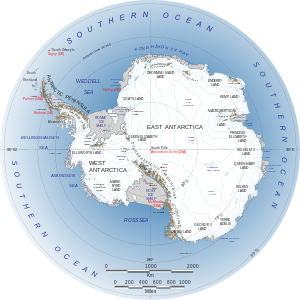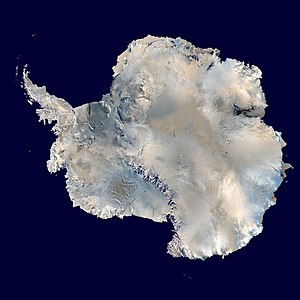Antarctica

Antarctica is Earth's southernmost and least-populated continent. Situated almost entirely south of the Antarctic Circle and surrounded by the Southern Ocean (also known as the Antarctic Ocean), it contains the geographic South Pole. Antarctica is the fifth-largest continent, being about 40% larger than Europe, and has an area of 14,200,000 km2 (5,500,000 sq mi). Most of Antarctica is covered by the Antarctic ice sheet.
Antarctica is, on average, the coldest, driest, and windiest of the continents, and it has the highest average elevation. It is mainly a polar desert, with annual precipitation of over 200 mm (8 in) along the coast and far less inland. The first confirmed landing was by a Norwegian team in 1895. In the early 20th century, there were a few expeditions into the interior of the continent. British explorers were the first to reach the magnetic South Pole in 1909, and the geographic South Pole was first reached in 1911 by Norwegian explorers.
Antarctica is governed by about 30 countries, all of which are parties of the 1959 Antarctic Treaty System. According to the terms of the treaty, military activity, mining, nuclear explosions, and nuclear waste disposal are all prohibited in Antarctica. Tourism, fishing and research are the main human activities in and around Antarctica. During the summer months, about 5,000 people reside at research stations, a figure that drops to around 1,000 in the winter. Despite the continent's remoteness, human activity has a significant effect on it via pollution, ozone depletion, and climate change. The melting of the potentially unstable West Antarctic ice sheet causes the most uncertainty in century-scale projections of sea level rise, and the same melting also affects the Southern Ocean overturning circulation, which can eventually lead to significant impacts on the Southern Hemisphere climate and Southern Ocean productivity.
Antarctica was adopted in the 1890s, with the first use of the name being attributed to the Scottish cartographer John George Bartholomew.
Geography

Positioned asymmetrically around the South Pole and largely south of the Antarctic Circle (one of the five major circles of latitude that mark maps of the world), Antarctica is surrounded by the Southern Ocean. Rivers exist in Antarctica; the longest is the Onyx. The lakes that lie at the base of the continental ice sheet occur mainly in the McMurdo Dry Valleys or various oases. Lake Vostok, discovered beneath Russia's Vostok Station, is the largest subglacial lake globally and one of the largest lakes in the world. It was once believed that the lake had been sealed off for millions of years, but scientists now estimate its water is replaced by the slow melting and freezing of ice caps every 13,000 years. During the summer, the ice at the edges of the lakes can melt, and liquid moats temporarily form. Antarctica has both saline and freshwater lakes.
Antarctica is divided into West Antarctica and East Antarctica by the Transantarctic Mountains, which stretch from Victoria Land to the Ross Sea.
East Antarctica comprises Coats Land, Queen Maud Land, Enderby Land, Mac. Robertson Land, Wilkes Land, and Victoria Land. All but a small portion of the region lies within the Eastern Hemisphere. East Antarctica is largely covered by the East Antarctic Ice Sheet. There are numerous islands surrounding Antarctica, most of which are volcanic and very young by geological standards.
Vinson Massif, in the Ellsworth Mountains, is the highest peak in Antarctica at 4,892 m (16,050 ft). Mount Erebus on Ross Island is the world's southernmost active volcano and erupts around 10 times each day. Ash from eruptions has been found 300 kilometres (190 mi) from the volcanic crater. There is evidence of a large number of volcanoes under the ice, which could pose a risk to the ice sheet if activity levels were to rise.[26] The ice dome known as Dome Argus in East Antarctica is the highest Antarctic ice feature, at 4,091 metres (13,422 ft). It is one of the world's coldest and driest places—temperatures there may reach as low as −90 °C (−130 °F), and the annual precipitation is 1–3 cm (0.39–1.18 in).
Magnetic Field Weakening
As of 2014, the rate of the earth’s magnetic field weakening had greatly increased. What was previously measured as a five percent weakening per hundred years, has now increased to a five percent weakening per decade. This allows the space weather or cosmic energy to penetrate and interact with the earth’s atmosphere and crust more and more. The Geomagnetic North pole is moving many kilometers a year across the Arctic Ocean towards Russia, while the Geomagnetic South Pole has left the continent of Antarctica and is moving towards the Indian Ocean. The Geomagnetic poles are moving every year towards the equator. There are massive changes occurring in the earth’s magnetic field that are transforming life on earth as we’ve known it, and yet the topic rarely makes the news.

